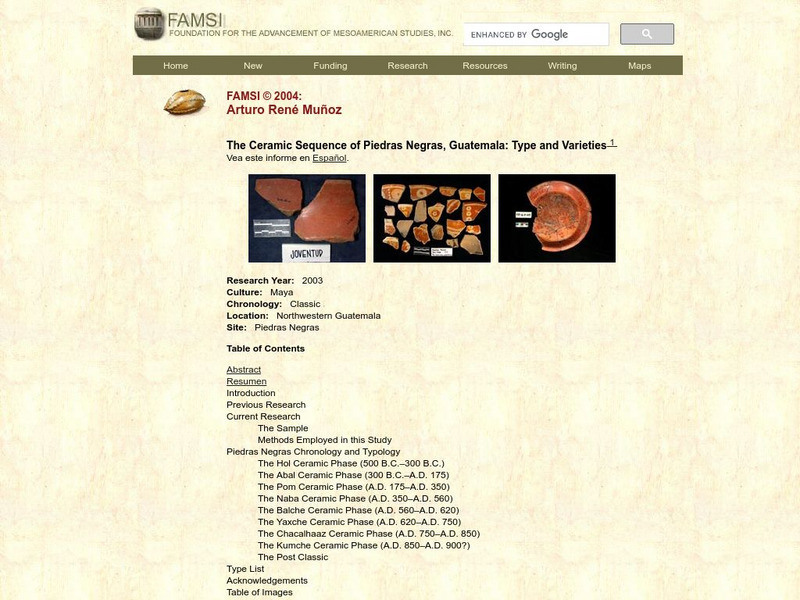Foundation for the Advancement of Mesoamerican Studies
Famsi: Early Copan Acropolis Program 2000 Field Season
Final report of archaeological data and conclusions of Mayan history at Hunal and Margarita tombs in Copan, Honduras. Information given on pottery, tools, agriculture, and fauna.
Foundation for the Advancement of Mesoamerican Studies
Famsi: Archaeological Research at Cotzumalhuapa, Guatemala
Research at Cotzumalhuapa indicates that it was a major urban center that encompassed Bilbao El Baul, and El Castillo. Some discussion of colonial period use of site.
Foundation for the Advancement of Mesoamerican Studies
Famsi: The Jolja' Cave Project (2001)
Three caves containing pre-Columbian artifacts, murals, and hieroglyphs are documented in this report. Also of interest is commentary on the reports of modern Ch'ol Mayans with regard to ancient belief and current religious belief.
Foundation for the Advancement of Mesoamerican Studies
Famsi: Economic Foundations of Mayapan Project (2001)
Although this excavation is still in progress, preliminary reports indicate occupants produced pottery for local and regional consumption. Also the production of tools and jewelry depended on materials from other parts of the region.
Foundation for the Advancement of Mesoamerican Studies
Famsi: Epi Classic Cultural Dynamics in the Mezquital Valley
Interesting study of artifacts used to demonstrate inter-regional trade in the Mezquital Valley area of Mexico during A.D. 600-1000. This work also offers good insights into specific cultures.
Foundation for the Advancement of Mesoamerican Studies
Famsi: Politics and Economics: Motul De San Jose, Peten
Excavations at Motul de San Jose indicate that the site was more populated than previously thought. Findings indicate that production of textiles, tools, and ceramics were carried out in this city-state.
Foundation for the Advancement of Mesoamerican Studies
Famsi: The Eastern Riverine Corridor During Late Classic Period
Inventories of ceramic materials and architectural similarities indicate that some urban centers may be socially and politically connected while others are not. Study confirms a water route from New River drainage area to Belize may have...
Foundation for the Advancement of Mesoamerican Studies
Famsi: Porta Incensario Restoration at Palenque, Chiapas (1998)
Discussion of procedures used to restore six porta incensarios recovered from the Temple of the Cross. Step by step process is revealed and pictures of before and after restoration are included.
Foundation for the Advancement of Mesoamerican Studies
Famsi: The Piedras Negras Project (2000)
Many details of the excavation processes at Piedras Negras allow researchers to write a probable history of the Mayan peoples who lived at this site until the time of its collapse.
Foundation for the Advancement of Mesoamerican Studies
Famsi: Ceramics at Piedras Negras, Guatemala (2001)
Researcher relates phases in ceramic ware to political and social events in the history of Mayan people at Piedras Negras.
Foundation for the Advancement of Mesoamerican Studies
Famsi: Teotihuacan in the Puuc Region: Foreign Presence?
Very detailed information regarding excavation at Chac II site and archaeological processes. The article articulates findings and makes inferences regarding urban culture. Site may be viewed in Spanish.
Foundation for the Advancement of Mesoamerican Studies
Famsi: Northern Belize Coastal Project, 1999
Archaeological investigations at Saktunja site in Belize focuses on inter-region trade networks and diversification strategies. Site can be viewed in English and Spanish.
Foundation for the Advancement of Mesoamerican Studies
Famsi: Obsidian Craft Production at Cacaxtia Xochitecatl (200)
Archaeological excavation at Xochitecatl indicate that it was an area of production for obsidian goods. Site can be viewed in English and Spanish.
Foundation for the Advancement of Mesoamerican Studies
Famsi: Chan Chich Proto Classic Tomb Project (1998)
Excavation of tomb indicates the occupant was elite as indicated by wooden snake. Several Mayan artifacts are pictured.
Foundation for the Advancement of Mesoamerican Studies
Famsi: Sculpture Reconstruction Copan, Honduras (2002)
Structure is discussed and well as its purpose as a dwelling place for a ruler/deity.
Foundation for the Advancement of Mesoamerican Studies
Famsi: Temple 22 Facade Reconstruction Project (2001)
Preliminary research indicates that structure was a sacred mountain used as a political center. Discussion of sculpture meanings is included.
Foundation for the Advancement of Mesoamerican Studies
Famsi: Examining Nature of Maya Collapse of Copan (1999) [Pdf]
Archaeological fieldwork focuses on severity and timing of factors that led to the collapse of Mayan culture.
Foundation for the Advancement of Mesoamerican Studies
Famsi: Report on Chan Chich Archaeological Project (1997) [Pdf]
Read a PDF file offering great detail and pictures of the excavation of the Chan Chich Archaeological Project.
Foundation for the Advancement of Mesoamerican Studies
Famsi: Ceramic Sequence of Piedras Negras, Guatemala (2003)
Report offers history of the production of ceramic pieces from 500 B.C. to 900 A.D. Photographs document each cultural phase and work. Readers can download this PDF at the bottom of the page.
Foundation for the Advancement of Mesoamerican Studies
Famsi: Study of Classic Maya Ritual at Copan (2002) [Pdf]
Analysis of burial deposits offer insights into ritual behaviors.
Foundation for the Advancement of Mesoamerican Studies
Famsi: Architectural Development of Structure at Nakbe, Peten
Study investigates the sequence in construction of building at Nakbe, Peten, Guatemala. Details include dimensions of steps and structures.
Library of Congress
Loc: Tortuguero Box
With the help of computer technology you can virtually explore this wooden box artifact from all sides. Also see a gallery of other Mayan art.
Curated OER
Vessel 8, Tomb 2, Chan Chich, Belize
Excavation of tomb indicates the occupant was elite as indicated by wooden snake. Several Mayan artifacts are pictured.


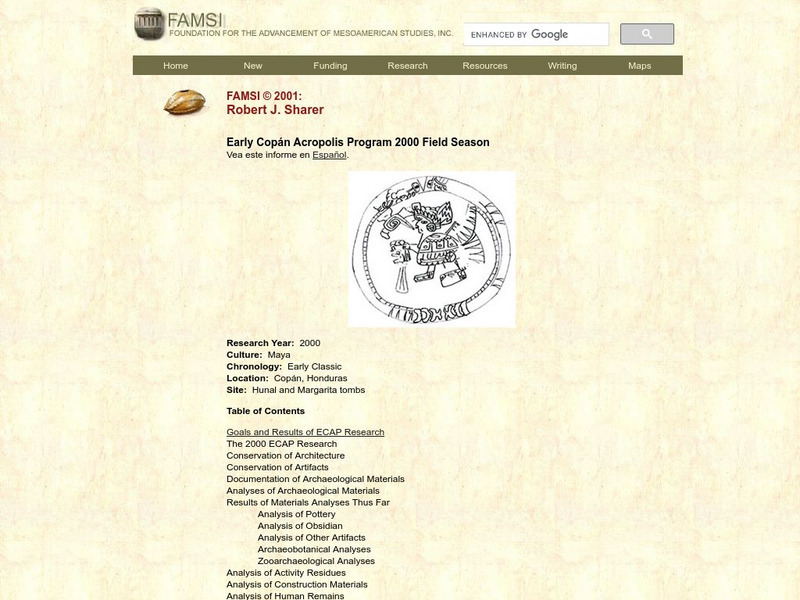
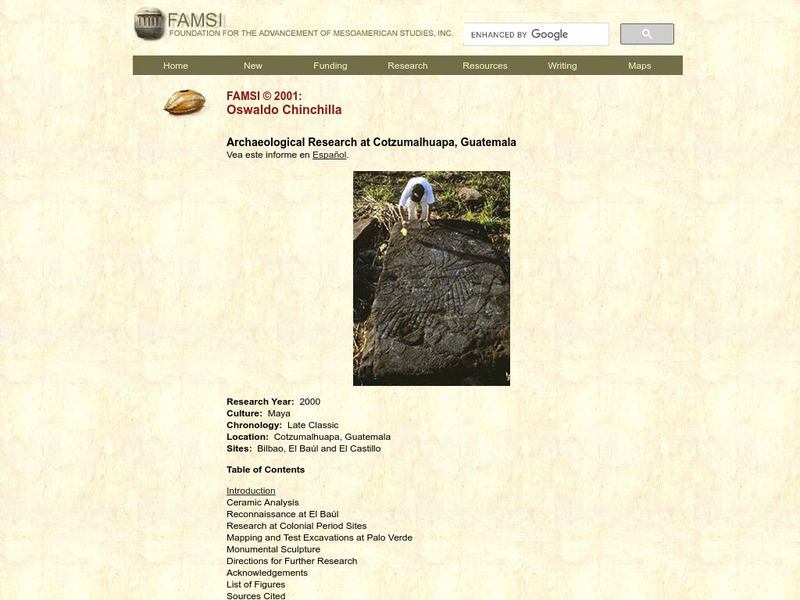




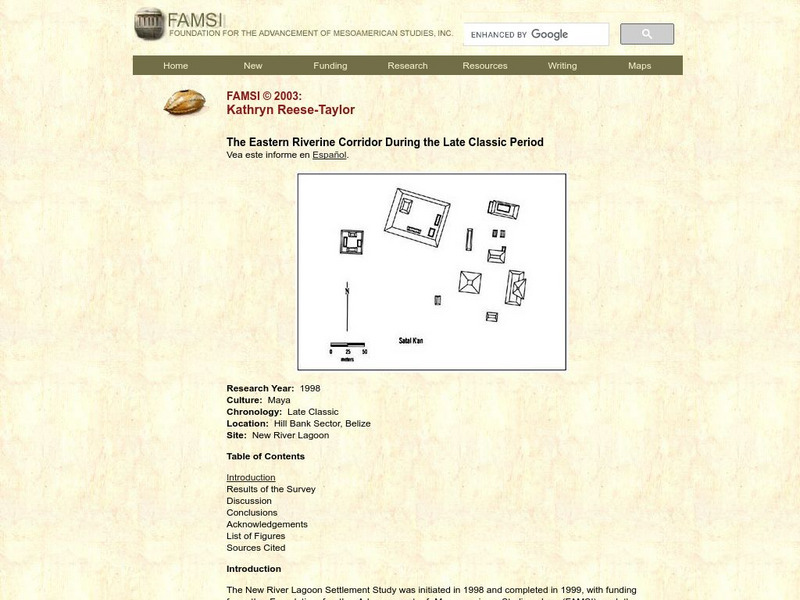

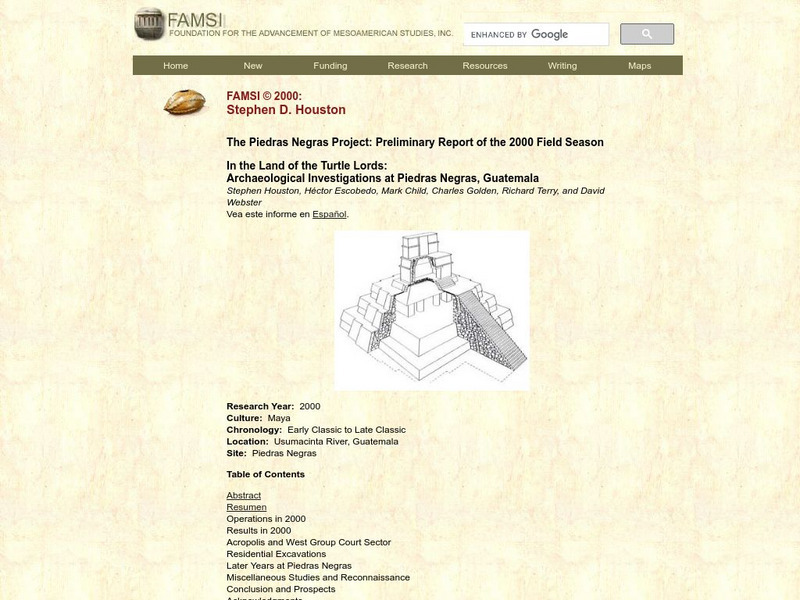




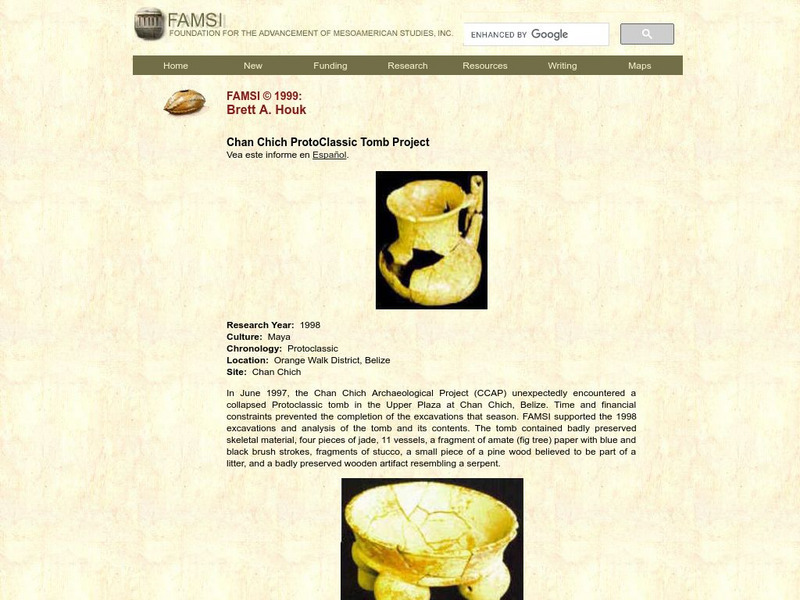


![Famsi: Examining Nature of Maya Collapse of Copan (1999) [Pdf] Handout Famsi: Examining Nature of Maya Collapse of Copan (1999) [Pdf] Handout](https://d15y2dacu3jp90.cloudfront.net/images/attachment_defaults/resource/large/FPO-knovation.png)
